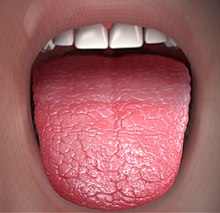User:Mr. Ibrahem/Xerostomia
| Xerostomia | |
|---|---|
| Other names | Dry mouth,[1] dry mouth syndrome[2] |
 | |
| Image of a dry mouth | |
| Pronunciation |
|
| Specialty | ENT surgery, dentistry |
| Symptoms | Dry mouth, cracked lips[3] |
| Complications | Cavities, decreased taste, bad breath, trouble chewing, swallowing, talking[1][3] |
| Usual onset | Older people[1][3] |
| Causes | Certain medications, Sjögren's, HIV/AIDS, diabetes, autoimmune disease, radiation therapy[1][3] |
| Diagnostic method | Based on symptoms[3] |
| Treatment | Drinking sufficient water, chewing gum, stopping smoking, using a humidifier at night, saliva substitutes[1] |
| Medication | Pilocarpine, physostigmine, cevimeline[3] |
| Prognosis | Depends on cause[3] |
| Frequency | 25%[3] |
Xerostomia, also known as dry mouth, is not having enough saliva to keep the mouth wet.[1] Other symptoms may include cracked or dry lips.[3] Complications can include cavities, decreased taste, bad breath, trouble chewing, swallowing, or talking.[1][3]
Causes include certain medications, Sjögren's, HIV/AIDS, diabetes, autoimmune disease, and radiation therapy.[1][3] Medications implicated may include diuretics such as furosemide, anticholinergics, antihistamines, blood pressure medication, antidepressants, and chemotherapy.[3] Breathing through the mouth is also a risk factor.[3] Diagnosis is generally based on symptoms.[3]
Treatment depends on the underlying cause.[1] Drinking sufficient water, chewing gum, stopping smoking, using a humidifier at night, and saliva substitutes may help.[1] The medications pilocarpine, physostigmine, or cevimeline may be used.[3] Outcomes depend on the underlying cause.[3]
A dry mouth is common affected about 20 to 30% of people.[3] It occurs more commonly in older people, due to its association with other health problems rather than it being a normal part of aging.[1][3] The condition first came to medical attention in 1868.[4] The word itself is derived from "xeros" meaning "dry" and "stoma" meaning "mouth".[4]
References[edit]
- ^ a b c d e f g h i j k l "Dry Mouth". www.nidcr.nih.gov. National Institute of Dental and Craniofacial Research. Archived from the original on 9 April 2021. Retrieved 10 July 2021.
- ^ Wijers OB, Levendag PC, Braaksma MM, Boonzaaijer M, Visch LL, Schmitz PI (2002), "Patients with head and neck cancer cured by radiation therapy: a survey of the dry mouth syndrome in long-term survivors", Head Neck, 24 (8): 737–747, doi:10.1002/hed.10129, PMID 12203798, S2CID 21262893.
- ^ a b c d e f g h i j k l m n o p q r Talha, B; Swarnkar, SA (January 2021). "Xerostomia". PMID 31424871.
{{cite journal}}: Cite journal requires|journal=(help) - ^ a b Sreebny, Leo M.; Vissink, Arjan (25 February 2010). Dry Mouth, The Malevolent Symptom: A Clinical Guide. John Wiley & Sons. p. IX. ISBN 978-0-8138-2097-2. Archived from the original on 27 August 2021. Retrieved 10 July 2021.
